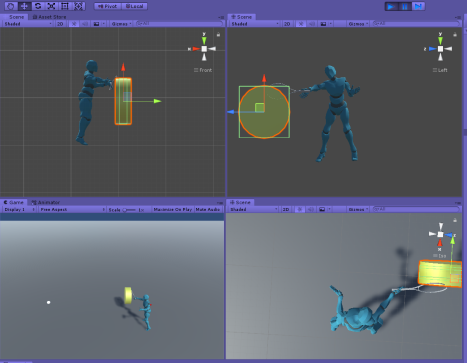Thank you so much for such a crystal clear, detailed response!
I'm leaning towards the former -- fake physics -- as that's what most if not all non-VR, non-1st person tennis games do.
My follow up question below mainly involves (TLDR:) how do I implement this in a logical, natural looking, and easily tunable way in order to account for every hitting angle in my game? (by hitting angle, I mean the difference in height[Y] between the players hip and the incoming ball),
Here's my thought process. Hope I'm not horribly over complicating it or going down the wrong path--
Assumptions:
Setting an IK target is relatively easy in Unity since I can just create an empty game object and make it a child of the ball, or just make the ball the target object directly.
Unity's IK solution only allows the hands or feet to be controlled by IK -- I am assuming IK cannot control the racket directly.
To make the racket position AND angle (z-rotation, like a windshield wiper) look precise and convincing, this would require an accurate X/Y/Z position at contact and some z-rotation of the racket if the ball is above or below the "comfort zone" -- comfort zone being between hip to shoulder height. I don't want IK or code to affect the Y and X rotation of the hand or racket.
For this case, let's set the sweet spot to a range around the player's hip height as the Y value for comfort zone, say Y = {1.0-1.5}. In other words, the comfort zone is the range of Y values where the racket can hit the ball and still be parallel to the ground at contact.
Setting the correct X/Y/Z position seems easy enough since hand y = racket y, and hand z = racket z, and hand x = [racket X - racket length], but the z-rotation (windshield wiper motion) of the racket is where things get tricky--
Need to decide on the min/max Y range of the player's hand y before the hand+racket is allowed to z-rotate upwards or downward (lets say Ymin/ymax is 1 and 1.5), and the min/max hand+racket z-rotation angle (let's say -80deg to +80deg), then use that z-rotation angle and the racket's length to calculate the "sweet spot" of the racket face. then in code (or IK?),offset the players X position in order to line up the racket and and ball exactly-- not sure if using transform.position or IK would be the better solution here?
Caveats:
My goal is to not change each animations elbow angle angle too much, but it would be super nice if there is a procedural way to add a little dynmaic extra elbow flexion or extension, and or shoulder raising/dropping and outward stretching or inward squashing (not sure if these are the right terms), depending on ball distance -- as long as it looks natural.
To sum everything up, I'm just trying to emulate what every AAA tennis game does to achieve proper contact of the racket with the ball in a more procedural way, to reduce the number of animations I would need to make. Please let me know if this seems like the right track!






